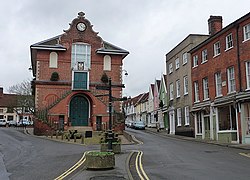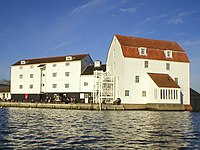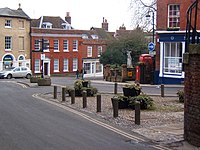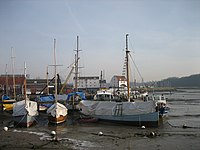Woodbridge
| Woodbridge | |
| Suffolk | |
|---|---|
 Shire Hall, Woodbridge | |
| Location | |
| Grid reference: | TM272491 |
| Location: | 52°5’37"N, 1°19’4"E |
| Data | |
| Population: | 10,956 (2001) |
| Post town: | WOODBRIDGE |
| Postcode: | IP12 |
| Dialling code: | 01394 |
| Local Government | |
| Council: | East Suffolk |
| Parliamentary constituency: |
Suffolk Coastal |
Woodbridge is a town in Suffolk, on the estuary of the River Deben as it opens into the North Sea. Woodbridge stands on the southern shore of the River Deben, while across the river is the most important Anglo-Saxon site in the United Kingdom; the Sutton Hoo burial ground with its famous ship burial.
With 1,400 years of recorded history, the town has retained a variety of historical architecture, and there are facilities for boating and riverside walks on the River Deben.
The town is served by Woodbridge railway station on the Ipswich-Lowestoft East Suffolk Line.
Contents
History and heritage
Archaeological finds in the area show habitation from the Neolithic Age (2500-1700 B.C.).
There is little evidence of a Roman presence. After the Roman departure, Woodbridge was at the heart of a new kingdom founded here by English settlers from across the sea, which became the Kingdom of the East Angles.
In the early 7th century King Rædwald of East Anglia was Bretwalda, the most powerful king in England. He died in around 624, and it is believed that his body was buried at Sutton Hoo, just across the river Deben from Woodbridge. Several royal burials have been found there, the most famous and most lavish being that which leaded a rich golden treasure, and which is now attributed to King Rædwald; the burial ship is 89 feet long, and when its treasures were discovered in 1939 they were the richest ever found in British soil. They are kept in the British Museum in London but replicas of some items, and the story of the finds, are to be found in the Woodbridge Museum, and the National Trust has built a Visitor Centre on the site.
The earliest record of Woodbridge dates from the mid-10th century, when it was acquired by St Aethelwold, Bishop of Winchester, who made it a part of the endowment of the monastery he helped to refound at Ely in Cambridgeshire in AD 970.
The Domesday Book of 1086 describes Woodbridge as part of the Loes Hundred. Much of Woodbridge was granted to the powerful Bigod family, who built the famous castle at Framlingham.
The town has been a centre for boat-building, rope-making and sail-making since the Middle Ages. Edward III and Sir Francis Drake had fighting ships built in Woodbridge. The town suffered in the plague of 1349, but recovered enough, and with encouragement from the Canons, and growing general prosperity, to have a new church (now St. Mary's, behind the buildings on the south side of Market Hill)) constructed with limestone from the Wash and decorated with Thetford flint. By the mid 15th century the Brews family had added a tower and porch.
On 12 October 1534, Prior Henry Bassingbourne acknowledged Henry VIII's supremacy over the Church and rejected the incumbent "Roman Bishop", but Woodbridge Priory was dissolved three years later.[1]
In the time of Henry's Romanist daughter Queen Mary I ("Bloody Mary"), Alexander Gooch, a weaver of Woodbridge, and Alice Driver of Grundisburgh were burnt for heresy on Rushmere Heath. Alice previously had her ears cut off for likening queen Mary to Jezebel. The restoration of the reformation under Elizabeth I helped Woodbridge industries such as weaving, sail-cloth manufacture, rope-making and salt making to prosper, along with the wool trade. The port was enlarged, and shipbuilding and timber trade became very lucrative, so that a customs house was established in 1589.
Churches
- Church of England:
- Baptist: http://www.woodbridgechurch.org.uk/ The Woodbridge Quay Church]
- Methodist: in St John's Street
- Salvation Army: Woodbridge Salvation Army in Gobitt's Yard,
- Roman Catholic: St Thomas of Canterbury
The Woodbridge Quay Church in Quay Street was once known as the Quay Meeting House. It took its present form when the town's Baptist and United Reformed congregations merged in 2006; it is now affiliated to the Baptist Union of Great Britain and to the Evangelical Alliance.
Sights about the town
Around the town there are various buildings from the Tudor, Georgian, Regency and Victorian eras. At the top of Market Hill stands the Shire Hall, and running up and down the hill from here are rows of pretty, colourful houses, and in the narrow roads such as Church Street and New Street winding down the hill.
On the hill above the opposite bank of the River Deben is an even older site; Sutton Hoo.
Woodbridge has a tide mill in working order; one of only two in the United Kingdom and among the earliest. The mill first recorded on the site in 1170 was run by the Augustinian canons. In 1536 it passed to King Henry VIII. In 1564, Queen Elizabeth I granted the mill and the priory to Thomas Seckford. In 1577 he founded Woodbridge School and the Seckford Almshouses, for the poor of Woodbridge.
Two windmills survive, Buttrum's Mill, and Tricker's Mill. The former is open to the public.[2]
Keen believers in UFOs often head to the Rendlesham Forest at Woodbridge, after "the Rendlesham Forest incident". In 1980, at the height of the Cold War, unexplained lights were reported in the sky close to RAF Woodbridge, a United States Airforce airfield, and there were claims that a UFO had landed in the forest. The incident continues to interest ufologists who argue amongst themselves about whether an alien spacecraft landed there.[3]
The town also has a well-maintained two-hectare walled park named Elmhurst Park.[4]
Big Society
The Excelsior is Woodbridge's own brass band. The Excelsior was formed in 1846 and is the oldest community brass band in East Anglia.[5]
There is a local radio station.[6]
Sport and leisure
- Football: Woodbridge Town FC, who play at Notcutts Park.
There are numerous clubs and associations in the town, including sports clubs for association football, badminton, birdwatching, bowls, cricket, cruising, netball, road running, rugby football, swimming, tennis and yachting.[7]
Outside links
| ("Wikimedia Commons" has material about Woodbridge) |
References
- ↑ The Abbey (Junior School), Woodbridge, British Listed Buildings. Retrieved 2011-05-01.
- ↑ Links to English Heritage descriptions: Retrieved 20 December 2010.
- ↑ The Rendlesham Forest UFO Incident. Retrieved 20 December 2010.
- ↑ Retrieved 20 December 2010.
- ↑ Retrieved 20 December 2010.
- ↑ Community Radio for Woodbridge & The Deben Valley. Retrieved 20 December 2010.
- ↑ Retrieved 20 December 2010.


